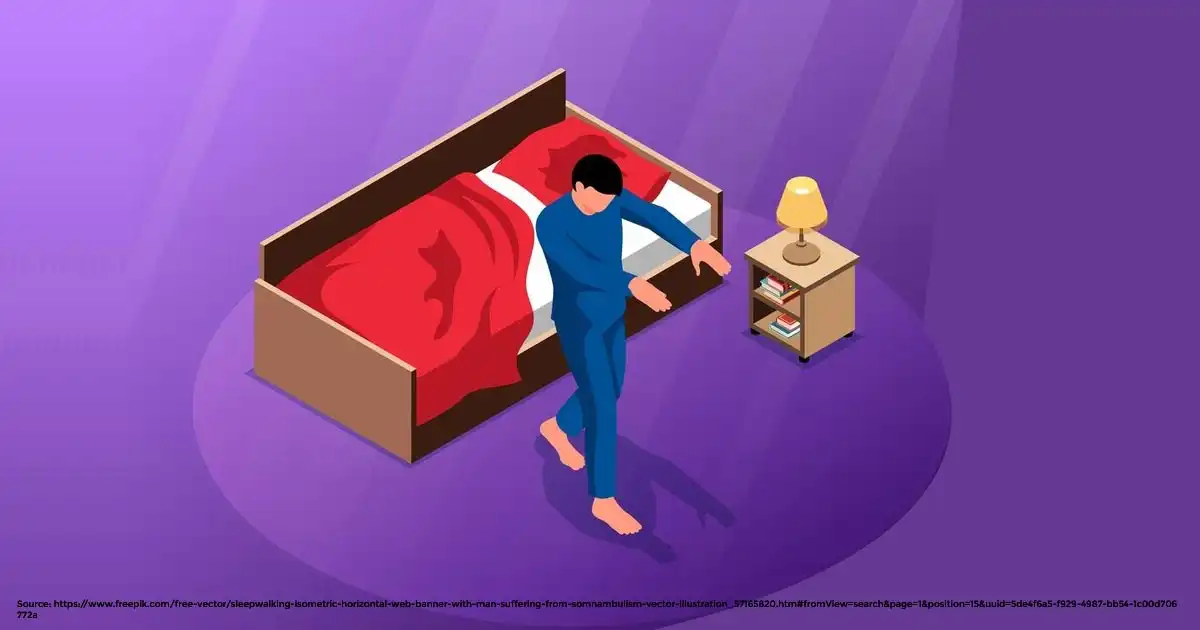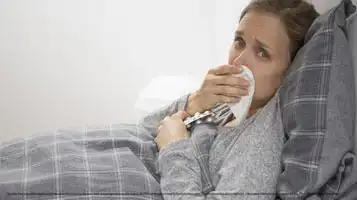What Is Sleepwalking? Explore It’s Causes & Risks Now

What is Sleepwalking?
Sleepwalking, officially known as somnambulism or walking during sleep, is a behavior disorder that originates during sleep. An individual affected by this condition walks during sleep or performs other complex behaviors, mostly in sleep.
Have you ever found yourself waking up confused in the middle of the night; that too in a different place? Well, you might have been sleepwalking. This intriguing disorder, known as somnambulism, prompts people to perform various activities while asleep, from simple walking to complex behaviors.
While it’s more common in children, adults can also experience it. Factors like genetics, stress, and sleep deprivation often trigger it. This phenomenon has puzzled scientists and sleep specialists for years. It’s not just about walking during sleep; individuals may sit in bed, look around with a glassy-eyed expression, or even engage in unusual activities.
But what causes a person to sleepwalk, and how can it be managed or treated?
Though sleepwalking episodes are typically brief, they can sometimes lead to risky situations. The disorder is often linked to genetics, stress, sleep deprivation, and other sleep disorders like Obstructive Sleep Apnea (OSA).
Understanding this sleep disorder is crucial, not only for the safety of the individual but also for the well-being of those around them. In this health article, we’ll explore the enigmatic nature of sleepwalking, its symptoms, causes, and treatment options to shed light on this intriguing phenomenon. There are 10 myths busted about it.
Definition
Sleepwalking, or somnambulism, is a condition where a person moves around or does things while they are still asleep. It’s like your body being on auto-pilot: the body is active, but the brain is still in its sleep cycle. People who sleepwalk might walk around, tidy up, or even eat without waking up.
It’s a bit of a family affair, too—it tends to happen in families, suggesting that genes play a role.
In the world of sleep science, this disorder falls under parasomnia, which is a fancy term for a sleep disorder depicting unusual behaviors occurring during sleep.
It’s one of those quirks of the human body that shows how complex and fascinating our sleep can be!
How Common is Its Occurrence?
Sleepwalking is more common than many people think.
Around 6.9% of the population will experience sleepwalking at some point in their lives.
It’s most likely to start when you’re a kid, with a good number of children—about 1% to 15%—taking unexpected night-time strolls, especially between the ages of 4 years and 8 years.
Here’s why you shouldn’t worry as much; in most cases it is usually just a phase. By the time children reach adulthood, the numbers of such episodes tend to drop.
Only about 1% to 1.5% of grown-ups find themselves sleep walking while catching Zzz’s. So, in most cases it’s a bit like losing your baby teeth or outgrowing your favorite sweater—most people leave this phase behind as they grow up.
However, certain triggers like stress, sleep deprivation for prolonged periods, thyroid issues or alcoholism and substance/drug abuse can lead to sleepwalking occurrences in adults. Let’s learn why.
Causes of Sleepwalking

Sleepwalking is a perplexing sleep disorder characterized by complex behaviors during sleep. It has intrigued researchers for decades. The exact cause remains elusive, numerous factors have been identified as potential contributors to the occurrence of such episodes.
Let’s discuss.
- Sleep Deprivation: Prolonged periods of inadequate sleep can disrupt neurotransmitter balance and brain activity, potentially increasing susceptibility to this sleep disorder.
- Stress: Anxiety and stress can exacerbate sleep disturbances, heightening the likelihood of its episodes.
- Fever: Elevated body temperature during illness can disrupt normal sleep patterns, leading to fragmented sleep and an increased risk of parasomnias like sleepwalking.
- Sleep Schedule Disruptions: Travel-related jet lag or frequent sleep interruptions can disrupt the natural sleep-wake cycle, making individuals more prone to walking in their sleep.
- Specific Gene Mutation: A specific gene mutation, HLA-DQB1*05, has been linked to a higher risk of sleepwalking, particularly in individuals of white ethnicity.
- Environmental Factors: While genetics play a significant role, environmental factors such as living conditions and upbringing may also influence the development of such behavior.
Risk Factors of Sleepwalking – If Any?
Risk factors play a crucial role in understanding the prevalence and likelihood of experiencing sleepwalking episodes. While the exact triggers for it remain elusive, several factors have been identified as potential contributors to the disorder.
- Genetics
This behavioral condition tends to run in families, suggesting a strong genetic component. If one parent has a history of sleepwalking, the likelihood of their offspring experiencing the disorder increases. Moreover, if both parents have a history of such a sleep disorder, the risk is significantly higher. This familial predisposition underscores the genetic influence on the development of this phenomena.
- Age
Sleepwalking occurs more frequently in children compared to adults. Children between the ages of 4 and 8 are particularly susceptible to such episodes. The prevalence tends to decrease as children age, with most outgrowing the condition by adolescence. However, onset in adulthood is less common and often associated with other underlying medical or psychological conditions.
- Medical Conditions
Certain medical conditions or factors may increase the risk of walking in sleep. These may include obstructive sleep apnea, restless legs syndrome, nighttime seizures, psychiatric disorders, and substance abuse. Additionally, individuals with a history of head injuries or neurological disorders may be more prone to sleepwalking.
- Drugs and Alcoholism
Certain substances may heighten its chances. These may include sedatives, hypnotics, antidepressants, and stimulants. Alcohol consumption and recreational drug use can also disrupt sleep architecture and predispose individuals to behave in odd manner during sleep.
What Triggers Sleepwalking Disorder?
As discussed earlier, this is a complex sleep disorder characterized by engaging in activities while still asleep. It can be triggered by various underlying conditions that disrupt normal sleep patterns.
These triggers can exacerbate the likelihood and frequency of sleepwalking episodes:
- Sleep-Disordered Breathing: Disorders characterized by abnormal breathing patterns during sleep, such as obstructive sleep apnea, can trigger sleepwalking. Interruptions in breathing can lead to fragmented sleep and arousal from deep sleep stages, increasing the likelihood of parasomnias.
- Restless Legs Syndrome (RLS): Restless legs syndrome, characterized by an irresistible urge to move the legs, particularly during periods of rest or inactivity, can disrupt sleep and increase arousal during the night. Individuals with RLS may experience fragmented sleep, leading to an increased risk of this condition.
- Gastro-Esophageal Reflux Disease (GERD): GERD, a condition characterized by the backflow of stomach acid into the esophagus, can cause discomfort and arousal from sleep. Episodes of GERD-related discomfort may trigger its episodes in susceptible individuals, particularly during the night.
- Personality: Certain personality traits or characteristics may predispose individuals to sleepwalking. Individuals who are highly suggestible, anxious, or prone to stress may be more susceptible to experiencing walking in the sleep episodes.
Personality factors can influence sleep quality and arousal thresholds during sleep, potentially increasing the likelihood of parasomnias.
- Feelings/Emotions: Emotional states and feelings can influence sleep quality and arousal during sleep. Stress, anxiety, fear, or excitement experienced during the day or before bedtime may carry over into sleep and manifest as sleepwalking episodes. Emotional arousal during sleep can disrupt normal sleep patterns and lead to sleep disorders including the one in discussion.
- Sleep Health and Comfortable Bed/Mattress: Disruptions to a healthy sleep routine, such as irregular sleep schedules or inadequate sleep hygiene practices, can contribute to sleep disturbances and increase the risk of this condition.
Additionally, discomfort or discomfort caused by an uncomfortable bed or mattress may disrupt sleep and trigger sleepwalking episodes in susceptible individuals. So, invest in a quality mattress for ensuring comfortable sleep all through the night.
Curious to know about healthy sleeping tips? Why don’t you add on some healthy sleep habits and maintain a consistent sleep schedule. It can further support overall sleep health and minimize the risk of sleepwalking.
These triggering factors underscore the multifaceted nature of sleepwalking and the various influences that can contribute to its occurrence. Addressing these triggers through lifestyle modifications, stress management techniques, and optimizing sleep environments can help reduce the frequency and severity of sleepwalking episodes.
Can Medications Trigger Sleepwalking?
Yes, medications play a crucial role in managing various medical conditions, but certain drugs can also potentially trigger sleepwalking episodes.
Research identifies several types of medication that may increase the risk of sleepwalking, although the exact mechanisms underlying this association are not fully understood.
Some medications potentially trigger sleepwalking. They include:
- Zolpidem (Ambien®): Zolpidem is a commonly prescribed medication for the short-term treatment of insomnia. While it is generally considered safe and effective, some individuals may experience sleepwalking or other sleep-related behaviors as a side effect.
- Quetiapine (Seroquel®): Quetiapine is an antipsychotic medication used to treat conditions such as schizophrenia, bipolar disorder, and major depressive disorder. Although relatively rare, sleepwalking has been reported as a possible side effect of Quetiapine use.
- Metoprolol (Lopressor®): Metoprolol is a beta-blocker medication commonly prescribed to treat high blood pressure, angina, and other cardiovascular conditions. While sleepwalking is not a common side effect of metoprolol, some individuals may experience unusual sleep behaviors while taking this medication.
If you suspect that a medication may be contributing to sleepwalking episodes, it’s essential to discuss your concerns with a healthcare provider.
They can review your medication regimen, assess your symptoms, and determine if there is a potential link between the medication and the sleepwalking episodes.
What Are Complications of Sleepwalking?
While sleepwalking itself is not usually a cause for concern, it can lead to several complications. Let’s read.
- Physical Injury
Sleepwalkers are at risk of hurting themselves, especially if they walk near furniture, descend stairs, or even leave the house. In rare cases, they might attempt to drive a car or consume inappropriate items during an episode.
- Sleep Disruption
Frequent episodes can cause significant sleep disruption, leading to excessive daytime sleepiness. This can affect cognitive functions and lead to issues with school performance or behavior.
- Social and Emotional Impact
Individuals who sleepwalk may feel embarrassed or anxious about their condition, which can strain social relationships. The fear of sleepwalking can also lead to anxiety about sleeping in unfamiliar environments or around others.
- Disturbance to Others
Sleepwalking can also disrupt the sleep of others in the household, especially if episodes are frequent or involve noise and movement around the house.
- Rare Cases of Harm to Others
Although uncommon, there is a potential for sleepwalkers to inadvertently cause injury to someone else during an episode.
Symptoms of Sleepwalking Disorder
Sleepwalking is characterized by complex behaviors and actions performed while still asleep.
Understanding the symptoms associated with sleepwalking disorder is crucial for recognizing and addressing the condition effectively and on time.
- Timing of Episodes
Sleepwalking typically occurs early in the night, usually one to two hours after falling asleep. It is unlikely to occur during daytime naps. Episodes of sleepwalking can vary in frequency, ranging from rare occurrences to more frequent episodes.
- Duration of Episodes
A sleepwalking episode generally lasts several minutes, although it can persist for a longer duration in some cases.
- Common Behaviors During Episodes
Individuals who are sleepwalking may exhibit various behaviors, as discussed under.
- Getting out of bed and walking around.
- Sitting up in bed and opening their eyes, often with a glazed or glassy-eyed expression.
- Failing to respond or communicate with others who attempt to interact with them.
- Being difficult to wake up during an episode.
- Experiencing disorientation or confusion for a short period after being awakened.
- Having no memory of the episode upon waking in the morning.
- Experiencing daytime impairment due to disturbed sleep patterns.
- Association with Sleep Terrors
Some individuals may experience sleep terrors in addition to sleepwalking. Sleep terrors are characterized by sudden arousal from sleep, often accompanied by intense fear or agitation.
- Complex Behaviors During Episodes
In some instances, individuals who are sleepwalking may engage in more complex behaviors, including:
- Performing routine activities such as getting dressed, talking, or eating.
- Leaving the house or wandering outside.
- Driving a car, posing a significant risk to themselves and others.
- Engaging in unusual behaviors, such as urinating in inappropriate places.
- Participating in sexual activity without awareness or consent.
- Risk of Injury
Sleepwalking poses a risk of injury to the individual experiencing the episode. Common injuries may include falls down stairs, jumping out of windows, or engaging in violent behavior during episodes of confusion immediately upon waking.
Sleepwalking and REM Sleep – Interrelated?
While the exact mechanisms underlying sleepwalking remain elusive, researchers have made significant strides in understanding its association with the various stages of sleep, particularly with Non Rapid Eye Movement (NREM) sleep.
Sleepwalking manifests during the deepest stage of NREM sleep known as N3 or slow-wave sleep. During this stage, the brain exhibits synchronized delta wave activity, and individuals typically experience reduced muscle tone and diminished responsiveness to external stimuli. Despite this apparent deep slumber, some individuals engage in complex behaviors characteristic of sleepwalking.
Rapid Eye Movement (REM) Sleep
The interrelation between sleepwalking and Rapid Eye Movement (REM) sleep, another distinct stage of the sleep cycle, remains a subject of interest and debate among researchers. While sleepwalking primarily occurs during NREM sleep, some studies suggest potential connections between sleepwalking episodes and disruptions in REM sleep architecture.
Furthermore, there’s evidence to suggest that sleep terrors, another NREM disorder characterized by intense fear and arousal during sleep, may co-occur with sleepwalking.
One prevailing hypothesis regarding the relationship between sleepwalking and REM sleep revolves around the intricate balance between various neurotransmitters and brain regions involved in regulating sleep-wake cycles. Dysfunction or dysregulation within these neural circuits could potentially lead to aberrant behaviors associated with parasomnias like sleepwalking.
Additionally, disruptions in the transition between different sleep stages, including NREM and REM sleep, might contribute to the onset of sleepwalking episodes.
While the exact mechanisms linking sleepwalking to REM sleep remain speculative, advances in neuro-imaging techniques and sleep research methodologies continue to shed light on the intricate workings of the sleeping brain.
Diagnosis & Tests of Sleepwalking Disorder
Diagnosing sleepwalking disorder typically involves a combination of clinical evaluation, patient history, and, in some cases, diagnostic testing.
Here’s how healthcare providers diagnose sleepwalking disorder:
- Clinical Evaluation: A healthcare provider can usually diagnose sleepwalking based on descriptions of the individual’s behavior during sleepwalking episodes. Loved ones who witness the episodes can provide valuable insights and detailed accounts of the behaviors exhibited during sleepwalking episodes. These firsthand observations are crucial for making an accurate diagnosis.
- Video Recordings: Video recordings taken by loved ones or through security systems can be helpful in documenting sleepwalking episodes. Since sleepwalking doesn’t occur every night, capturing episodes on video provides tangible evidence for healthcare providers to assess and analyze.
- Sleep Study (Polysomnography): While not always necessary, a full sleep study, also known as polysomnography, is considered the gold standard medical test to confirm sleepwalking.
During a polysomnography session, various parameters such as brain activity, muscle activity, eye movements, heart rate, and breathing patterns are monitored while the individual sleeps.
This comprehensive evaluation can help confirm the presence of sleepwalking and assess its severity.
- Sleep Study: Healthcare providers may recommend a sleep study if:
- They suspect that the sleepwalking symptoms may be due to another underlying condition, such as sleep-related seizures or rapid eye movement behavior disorder.
- Sleepwalking episodes result in injury to the individual or disrupt the sleep of others in the household.
- Other Diagnostic Tests: In some cases, healthcare providers may recommend additional tests to rule out conditions that may be related to sleepwalking. These tests may include:
- Electromyography (EMG): This test measures muscle activity and can help identify abnormal movements or behaviors during sleep.
- Electroencephalography (EEG): EEG measures brain wave activity and can help detect abnormalities in brain function during sleep.
These diagnostic tests are used to differentiate sleepwalking from other sleep disorders and medical conditions that may mimic its symptoms. By accurately diagnosing sleepwalking disorder, healthcare providers can develop appropriate treatment plans and strategies to manage and mitigate its impact on individuals’ sleep quality and overall well-being.
Somnambulism: Management & Treatment

Managing and treating somnambulism, commonly known as sleepwalking, typically involves a combination of nonmedication approaches and, in some cases, pharmacological interventions. While there isn’t a definitive cure for sleepwalking, various strategies can help reduce the frequency and severity of episodes.
Here’s how sleepwalking can be managed and treated:
1. Mental Health Therapy (Psychotherapy)
Engaging in psychotherapy with a mental health provider can help address underlying psychological factors such as anxiety, stress, or other emotional issues that may contribute to sleepwalking episodes.
Cognitive-Behavioral Therapy (CBT) techniques may be particularly beneficial in managing stress and improving sleep quality.
2. Relaxation and Stress Management Techniques
Since stress and anxiety can trigger sleepwalking episodes, implementing relaxation techniques such as deep breathing exercises, meditation, or mindfulness practices may help reduce stress levels and lower the likelihood of triggering a sleepwalking episode.
3. Treating Underlying Disorders
Addressing underlying sleep disorders that contribute to arousal from sleep, such as obstructive sleep apnea, can help reduce disordered arousals and minimize the occurrence of sleepwalking episodes.
Effective management of these conditions may involve lifestyle modifications, Continuous Positive Airway Pressure (CPAP) therapy, or other treatments as recommended by healthcare providers.
4. Scheduled Waking
Sleepwalking episodes often occur with predictable timing, usually within the first few hours of falling asleep. Scheduled waking involves gently arousing the individual from sleep 15 to 30 minutes before the anticipated onset of a sleepwalking episode.
This intervention can disrupt the sleep cycle and prevent the occurrence of sleepwalking episodes.
5. Medications for Sleepwalking
While there are no FDA-approved medications specifically for sleepwalking, healthcare providers may prescribe certain medications that affect neurotransmitter levels to help manage symptoms. These medications may include:
– Gabapentin: Although primarily used to treat epilepsy and neuropathic pain, gabapentin may be prescribed off-label to reduce the frequency and severity of sleepwalking episodes.
– Antidepressants: Selective serotonin reuptake inhibitors (SSRIs) or tricyclic antidepressants (TCAs) may be prescribed to help regulate sleep patterns and manage underlying anxiety or depression contributing to sleepwalking.
– Sedatives: In some cases, sedative medications may be prescribed to help individuals remain asleep and reduce the likelihood of arousal during sleep, thereby minimizing sleepwalking episodes.
We recommend that you work closely with a healthcare provider to determine the most appropriate treatment approach based on individual needs and circumstances.
How To Prevent Sleepwalking?
While sleepwalking may be unpredictable and its exact causes not fully understood, there are steps individuals can take to reduce the risk of experiencing sleepwalking episodes. While it may not be entirely preventable, implementing certain strategies can help minimize the frequency and severity of sleepwalking.
Here are some measures to consider for preventing sleepwalking.
1. Establish Good Sleep Hygiene
Good sleep hygiene refers to a set of practices and habits that promote healthy, restful sleep. These practices can significantly impact both mental and physical health. Here’s how:
Mental Health Benefits:
Improved Mood: Good sleep hygiene can help regulate emotions and improve mood stability. Adequate sleep is linked to lower rates of depression and anxiety.
Better Stress Management: Quality sleep can enhance coping with stress. It allows the brain to process emotions and experiences, reducing the impact of stressors.
Enhanced Cognitive Function: Sleep is crucial in memory consolidation, learning, and problem-solving. Good sleep hygiene can improve concentration and cognitive performance.
Reduced Risk of Mental Health Disorders: Consistent, quality sleep is associated with a lower risk of developing mental health disorders such as depression, anxiety, and bipolar disorder.
Physical Health Benefits:
Improved Immune Function: Sleep helps support a healthy immune system. Adequate rest can reduce the risk of infections and promote faster recovery from illness.
Healthy Weight Maintenance: Poor sleep is linked to weight gain and obesity. Good sleep hygiene can help regulate appetite hormones and support weight management efforts. Several studies confirm that improved sleep hygiene may lead to weight loss.
Reduced Risk of Chronic Diseases: Adequate sleep is associated with a lower risk of developing chronic conditions such as heart disease, diabetes, and stroke.
Enhanced Physical Performance: Quality sleep is crucial for athletic performance and recovery. It supports muscle repair, coordination, and overall physical endurance.
Tips for Good Sleep Hygiene:
Consistent Sleep Schedule: Maintain a fixed time of going to sleep and waking up at the same time. Do this even on weekends.
Create a Relaxing Bedtime Routine: Your sleep ambiance needs to be calm and tranquil. Indulge in reading a light story, listen to soothing music, or enjoy a warm bath. These activities will signal to your body that it’s time to sleep.
Prepare a Comfortable Sleep Environment: Your bedroom should have a comfortable mattress, pillows, and a cool, dark, quiet atmosphere.
Put a to Limit Screen Time: Avoid using devices like phones, tablets, and computers at least an hour before bed. This way you put a limit to screen time. The blue light can interfere with your body’s natural sleep-wake cycle – circadian rhythms.
Avoid Stimulants: Avoid caffeine and nicotine intake before you hit the bed.
Regular Physical Activity: Regular physical activity refreshes your body and mind. Avoid vigorous exercise close to bedtime.
Healthy Diet: Observe a balanced diet and do not eat heavy meals before bedtime.
Stress Management: Before bed, practice stress-reducing techniques such as meditation, yoga, or deep breathing exercises to promote relaxation.
Seek Professional Help: If you have persistent sleep issues, consult a healthcare professional to rule out any underlying sleep disorders and receive appropriate treatment.
These practices in your daily routine can improve your sleep quality and enhance mental and physical health.
2. Prioritize Sufficient Sleep
Ensure that you allocate enough time for sleep each night to meet your body’s sleep needs. Avoiding sleep deprivation can help stabilize sleep patterns and reduce the likelihood of sleepwalking episodes.
3. Address Underlying Sleep Disorders
Evaluate and address any underlying sleep disorders that may contribute to sleepwalking, such as obstructive sleep apnea or restless legs syndrome. Seeking medical evaluation and treatment for these conditions can help reduce the likelihood of sleepwalking episodes.
4. Create a Safe Sleep Environment
Minimize potential hazards in your sleep environment to prevent injury during sleepwalking episodes. Remove obstacles and sharp objects from pathways, lock doors and windows, and consider installing safety gates or alarms to alert caregivers of sleepwalking behavior.
5. Seek Professional Guidance
Consult a healthcare provider or sleep specialist for personalized recommendations and interventions to manage sleepwalking. They can provide further guidance on preventive measures tailored to your needs and circumstances.
While sleepwalking may not be entirely preventable, taking proactive steps to promote good sleep hygiene, prioritize sleep quality, and address underlying factors contributing to sleep disturbances can help reduce the frequency and severity of sleepwalking episodes.
Prognosis/Outlook
Understanding the prognosis or outlook for individuals who experience sleepwalking, also known as somnambulism, is essential for managing the condition and minimizing associated risks.
Here’s what to expect regarding the prognosis, duration, and potential complications of sleepwalking:
- What Are The Risks Of Injury?
Sleepwalking increases the risk of injury due to activities performed while not fully conscious. Individuals may inadvertently engage in hazardous behaviors such as slipping and falling, wandering outside, or even engaging in inappropriate or unsafe actions toward others, including sexsomnia. It’s crucial to take preventive measures and safety precautions to minimize the risk of injury during sleepwalking episodes.
- Tell Us Something About The Duration Of Sleepwalking Episodes.
Sleepwalking is more common in children and tends to decrease in frequency as individuals reach puberty. While most children outgrow sleepwalking, around 1% may continue to experience episodes into adulthood. However, even for those who continue to sleepwalk, episodes typically become less frequent as they age.
- What Are The Complications Involved?
While sleepwalking itself is usually not serious, it can lead to complications due to the potential for injury. Falls down stairs, jumping out of windows, sleepwalking while driving, and engaging in activities such as eating or cooking while asleep pose significant risks. Although instances of violent behavior during sleepwalking are rare, they can occur and may result in harm to oneself or others.
- Given The Potential Risks How Can We Manage And/Or Prevent Sleepwalking?
Given the potential risks associated with sleepwalking, it’s important to implement strategies to manage and prevent episodes. This may include optimizing sleep hygiene, addressing underlying sleep disorders, creating a safe sleep environment, and seeking professional guidance for personalized treatment and interventions.
How To Live With Sleepwalking? 5 Smart Tips Unveiled
Living with sleepwalking requires proactive measures to ensure safety and minimize the risk of injury or harm.
Here are some possible smart tips that you can practice to live with sleepwalking.
1. Tip 1: Lock Doors and Windows
People who sleepwalk often have difficulty with problem-solving and complex actions. Installing locks and latches on doors and windows can limit how far a sleepwalker can wander and prevent injuries. Ensure that all entrances and exits are secured before bedtime to reduce the risk of sleepwalking-related accidents.
2. Tip 2: Secure Dangerous Items
Take precautions to secure any items that could cause injury if accessed during a sleepwalking episode. Ensure that firearms, sharp objects such as knives, tools, and potentially harmful substances are safely stored and inaccessible to sleepwalkers. Even though the likelihood of accessing these items during sleepwalking may be low, it’s essential to prioritize safety and minimize risks.
3. Tip 3: Remove Breakable Objects
Minimize the risk of injury by removing breakable objects from the sleepwalking environment. Replace windows and sliding door glass with safer materials or break-resistant alternatives. Remove fragile items such as lamps, decorations, or glassware from areas accessible to sleepwalkers to prevent accidental breakage and injuries.
4. Tip 4: Modify Home Decorations and Layout
Assess the layout of your home and make necessary modifications to minimize fall hazards. Remove low furniture items, tables, rugs, and power cords that could pose a tripping hazard to sleepwalkers. Use gate-type barriers to block access to stairs and elevated areas to prevent falls. Consider sleeping in ground-floor bedrooms and avoiding bunk beds to reduce the risk of injury from falls.
5. Tip 5: Use Sound-Producing Devices
Install bells or other sound-producing, motion-sensitive devices in the sleepwalking area. These devices can potentially wake up the sleepwalker or alert caregivers to the occurrence of a sleepwalking episode, allowing for timely intervention and prevention of accidents.
When Should You Visit a Healthcare Professional?
While occasional episodes of sleepwalking are often harmless and resolve on their own, there are certain circumstances in which it’s important to seek guidance from a healthcare professional.
Here’s when you should visit your doctor.
- You Are Having Frequent Episodes
If sleepwalking occurs frequently, such as more than one to two times a week or multiple times during a single night, it may indicate an underlying issue that warrants medical attention. Persistent and frequent sleepwalking episodes may require further evaluation and management by a healthcare provider.
- Sleepwalking Is Leading To Dangerous Behavior or Injury
Seek medical advice if sleepwalking episodes result in dangerous behavior or injury to the individual who sleepwalks or to others. Activities such as wandering outside, driving a vehicle, or engaging in risky behaviors pose significant safety risks and should be addressed promptly by a healthcare professional.
- You Are Routinely Facing Sleep Disruptions
If sleepwalking episodes cause significant disruption to the sleep of household members or the individual who sleepwalks, it may impact overall well-being and quality of life. Persistent sleep disruption can lead to daytime symptoms of excessive sleepiness, fatigue, and impaired functioning, necessitating medical intervention.
- You Are Showing Daytime Symptoms
Pay attention to daytime symptoms that may indicate underlying sleep disturbances or other health concerns. Excessive sleepiness, difficulty concentrating, irritability, or problems functioning during the day may be indicative of sleepwalking-related sleep disruption and should be discussed with a doctor.
- You Did Not Sleepwalk As a Child
If sleepwalking starts for the first time in adulthood, it may signify an underlying medical or psychological condition that requires evaluation by a healthcare professional. Adult-onset sleepwalking warrants thorough assessment to rule out potential contributing factors and ensure appropriate management.
- Continuation into Teen Years
While sleepwalking is more common in children, it typically resolves as they reach puberty. If sleepwalking persists into the teenage years, it may indicate underlying issues that need to be addressed by a healthcare provider.
By seeking timely medical advice, you and your family can better understand and address sleepwalking-related concerns. This will eventually improv your sleep quality and overall health.
What Questions Should You Ask Your Doctor?
When discussing sleepwalking with your healthcare provider, it’s important to ask relevant questions to gain a better understanding of the condition and its management. Here are some questions you may consider asking:
1. Causes of Sleepwalking
Q1. What factors could be contributing to sleepwalking episodes in me (or my child)?
Q2. Are there any underlying medical conditions or sleep disorders that may be associated with sleepwalking?
2. Signs of Seriousness
Q 1. What symptoms or behaviors should I watch for that might indicate a more serious underlying issue related to sleepwalking?
Q 2. Are there any red flags that suggest the need for further medical evaluation or intervention?
3. Prevention Strategies
Q 1. What steps can I take to prevent or reduce the frequency of sleepwalking episodes?
Q 2. Are there lifestyle modifications or environmental changes that may help minimize the risk of sleepwalking?
4. When to Seek Medical Attention
Q 1. What are some signs or symptoms that indicate I should contact your office or seek medical attention regarding sleepwalking?
Q 2. When is it appropriate to consider scheduling a follow-up appointment or seeking a referral to a sleep specialist?
By asking these questions, you can self-introspect into the underlying factors contributing to your sleepwalking episodes. This will give you more clarity and build your confidence, keeping you well-prepared to visit your healthcare provider.
Open communication with your healthcare provider is effective to manage sleepwalking and ensure the safety and well-being of yourself or your family member.
Here are some intriguing myths about sleepwalking and the related facts:
1: Sleepwalkers Can Perform Complex Tasks
Fact: While some affected individuals might engage in simple actions like walking or sitting up, performing complex tasks like cooking or driving is extremely rare.
2: Sleepwalkers Always Return to Bed
Fact: Sleepwalkers can wander away from their bed or even outside the house, especially if safety measures aren’t in place.
3: Sleepwalkers Act Out Their Dreams
Fact: This condition occurs during non-REM sleep, so it’s not directly related to dreams. Dream enactment behavior is more characteristic of REM sleep behavior disorder.
4: Sleepwalkers Have Superhuman Strength
Fact: While some sleepwalkers might exhibit increased strength, it’s not superhuman. They can still be gently guided back to bed without much difficulty.
5: Sleepwalkers Can See in the Dark
Fact: Sleepwalkers typically have impaired vision and may not be able to see well in the dark. This can increase the risk of injury during episodes.
6: Sleepwalking is Always Dangerous
Fact: While this condition can pose risks, not all episodes result in harm. Implementing safety measures can reduce the risk of injury.
7: Sleepwalkers Are Unconscious
Fact: Sleepwalkers are in a state of altered consciousness. They may respond to simple commands and can sometimes even hold a conversation, albeit with difficulty.
8: It is a Sign of Mental Illness
Fact: This sleep disorder is usually a benign condition and not necessarily indicative of mental illness. It can be triggered by factors like stress, fever, or sleep deprivation.
9: Sleepwalkers Shouldn’t Be Disturbed
Fact: While it’s important to handle sleepwalkers gently, it’s safer to guide them back to bed to prevent accidents. Waking them won’t harm them.
10: Sleepwalkers Are Asleep the Whole Time
Fact: Sleepwalkers can appear awake and alert during episodes, but they are still in a sleep state. Their actions are often automatic and not under conscious control.
These myths and facts highlight the complexities of sleepwalking and aim to dispel misconceptions surrounding this intriguing sleep disorder.
FAQs on Sleepwalking Disorder
1. Is sleepwalking a mental disorder?
Sleepwalking typically doesn’t indicate a severe disorder but may hint at underlying issues. Although sleepwalkers seldom engage in hazardous activities, precautions against potential harm, like falling or climbing, are advisable.
2. How do you deal with someone who sleep walks?
When encountering a sleepwalker, ensuring their safety is paramount. Gently guiding them back to bed with reassurance is advisable. Avoid startling or restraining them unless there’s immediate danger to prevent potential harm.
3. Why did I start sleepwalking?
Sleepwalking, a disorder characterized by activities during sleep, can stem from various factors like genetics, stress, medication, and sleep deprivation. While it can affect both children and adults, it’s more prevalent in childhood.
4. What do Sleepwalkers do?
Sleepwalking, or somnambulism, entails walking or performing actions while asleep. More common in children, it often resolves with age and typically doesn’t necessitate treatment.
5. Is sleep walking part of ADHD?
Children with ADHD may exhibit increased nocturnal activity during sleep. This includes frequent and prolonged movement of limbs, but sleepwalking itself is not considered a direct symptom of ADHD.
6. What is sexomnia?
Sexomnia, categorized as a parasomnia, involves engaging in sexual behaviors during sleep. Like other parasomnias such as sleepwalking, it occurs during sleep stages and may require management.
7. Can Sleepwalkers recognize people?
While sleepwalkers may have their eyes open and recognize individuals, their judgment and behavioral responses are altered during sleep, leading to nonsensical actions.
8. Is it true you shouldn’t wake a sleepwalker?
Experts caution against waking sleepwalkers due to unpredictable reactions, which could leave them disoriented and confused. It’s generally safer to ensure their environment is hazard-free and guide them gently back to bed.
9. Does anxiety cause sleepwalking?
Research suggests a correlation between anxiety, stress, childhood trauma, and an increased risk of sleepwalking. Additionally, certain medical conditions like thyroid disorders can also play a role.
10. Is sleepwalking a narcolepsy?
Although narcolepsy and sleepwalking are distinct disorders, a significant percentage of narcoleptic patients may also experience non-REM parasomnias like sleepwalking. However, they are not inherently linked conditions.
References
- Stallman, H.M. and Kohler, M., 2016. Prevalence of sleepwalking: a systematic review and meta-analysis. PloS one, 11(11), p.e0164769.
https://www.ncbi.nlm.nih.gov/pmc/articles/PMC5104520/
- Lopez, R., Jaussent, I., Scholz, S., Bayard, S., Montplaisir, J. and Dauvilliers, Y., 2013. Functional impairment in adult sleepwalkers: a case-control study. Sleep, 36(3), pp.345-351.
- El Shakankiry, H.M., 2011. Sleep physiology and sleep disorders in childhood. Nature and Science of Sleep, pp.101-114.
https://www.ncbi.nlm.nih.gov/pmc/articles/PMC3630965/
- Hu, M.T., 2020. REM sleep behavior disorder (RBD). Neurobiology of Disease, 143, p.104996.
https://www.sciencedirect.com/science/article/pii/S0969996120302710
- Chopra, A., Patel, R.S., Baliga, N., Narahari, A. and Das, P., 2020. Sleepwalking and sleep-related eating associated with atypical antipsychotic medications: Case series and systematic review of literature. General Hospital Psychiatry, 65, pp.74-81.
https://www.sciencedirect.com/science/article/abs/pii/S016383432030075X
Disclaimer
The content provided here aims to deliver general guidance and should not replace professional advice. It is meant to enhance knowledge and not for diagnosing sleep or health concerns. So, before you make any changes to your sleep routine, it’s essential to consult your healthcare professional for personalized care and assistance.







